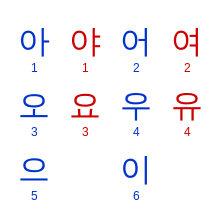Korean language
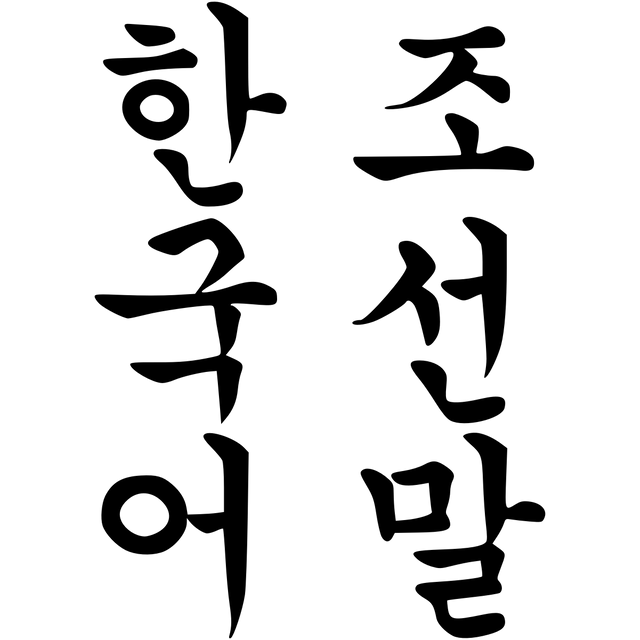
Korean language

| Korean | |
|---|---|
| 한국어/韓國語(South Korea) 조선말/朝鮮말(North Korea) | |
| Pronunciation | [tso.sʌn.mal](North Korea) [ha(ː)n.ɡu.ɡʌ](South Korea) |
| Native to | Korea |
| Ethnicity | Koreans |
Native speakers | 77.2 million (2010)[1] |
Koreanic
| |
Early forms | Proto-Koreanic
|
Standard forms | Munhwa'ŏ (North Korea) Pyojuneo (South Korea) |
| Dialects | Korean dialects |
Writing system | Hangul/Chosŏn'gŭl Korean Braille Hanja/Hancha |
| Official status | |
Official language in | |
Recognised minority language in | |
| Regulated by | The Language Research Institute, Academy of Social Science(사회과학원 어학연구소/社會科學院 語學研究所) (Democratic People's Republic of Korea) National Institute of the Korean Language(국립국어원/國立國語院) (Republic of Korea) China Korean Language Regulatory Commission(중국조선어규범위원회/中国朝鲜语规范委员会) (People's Republic of China) |
| Language codes | |
| ISO 639-1 | ko [83] |
| ISO 639-2 | kor [84] |
| ISO 639-3 | Variously:kor – Modern Koreanjje – Jejuokm – Middle Koreanoko – Old Koreanoko – Proto-Korean |
Linguist List | okm [85]Middle Korean |
oko [86]Old Korean | |
| Glottolog | kore1280 [87][2] |
| Linguasphere | 45-AAA-a |
 Countries with native Korean-speaking populations (established immigrant communities in green). | |
The Korean language (South Korean: 한국어/韓國語 Hangugeo; North Korean: 조선말/朝鮮말 Chosŏnmal) is an East Asian language spoken by about 77 million people.[3] It is a member of the Koreanic language family and is the official and national language of both Koreas: North Korea and South Korea, with different standardized official forms used in each country. It is also one of the two official languages in the Yanbian Korean Autonomous Prefecture and Changbai Korean Autonomous County of Jilin province, China. It is also spoken in parts of Sakhalin, Ukraine, and Central Asia.[4][5]
Historical and modern linguists classify Korean as a language isolate;[6][7][8] however, it does have a few extinct relatives, which together with Korean itself and the Jeju language (spoken in the Jeju Province and considered somewhat distinct) form the Koreanic language family. The linguistic homeland of Korean is suggested to be somewhere in Manchuria.[4]
| Korean | |
|---|---|
| 한국어/韓國語(South Korea) 조선말/朝鮮말(North Korea) | |
| Pronunciation | [tso.sʌn.mal](North Korea) [ha(ː)n.ɡu.ɡʌ](South Korea) |
| Native to | Korea |
| Ethnicity | Koreans |
Native speakers | 77.2 million (2010)[1] |
Koreanic
| |
Early forms | Proto-Koreanic
|
Standard forms | Munhwa'ŏ (North Korea) Pyojuneo (South Korea) |
| Dialects | Korean dialects |
Writing system | Hangul/Chosŏn'gŭl Korean Braille Hanja/Hancha |
| Official status | |
Official language in | |
Recognised minority language in | |
| Regulated by | The Language Research Institute, Academy of Social Science(사회과학원 어학연구소/社會科學院 語學研究所) (Democratic People's Republic of Korea) National Institute of the Korean Language(국립국어원/國立國語院) (Republic of Korea) China Korean Language Regulatory Commission(중국조선어규범위원회/中国朝鲜语规范委员会) (People's Republic of China) |
| Language codes | |
| ISO 639-1 | ko [83] |
| ISO 639-2 | kor [84] |
| ISO 639-3 | Variously:kor – Modern Koreanjje – Jejuokm – Middle Koreanoko – Old Koreanoko – Proto-Korean |
Linguist List | okm [85]Middle Korean |
oko [86]Old Korean | |
| Glottolog | kore1280 [87][2] |
| Linguasphere | 45-AAA-a |
 Countries with native Korean-speaking populations (established immigrant communities in green). | |
History
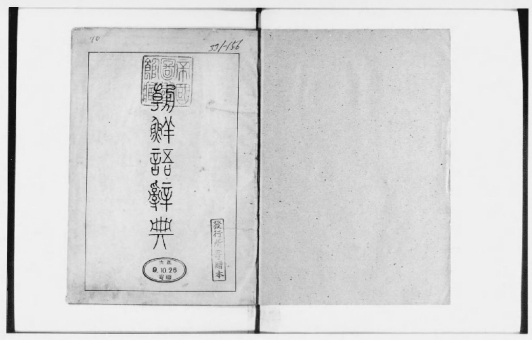
The oldest Korean dictionary.(1920)
Modern Korean descends from Middle Korean, which in turn descends from Old Korean, which descends from the Proto-Koreanic language which is generally suggested to have its linguistic homeland somewhere in Manchuria.[9][10] Whitman (2012) suggests that the proto-Koreans, already present in northern Korea, expanded into the southern part of the Korean Peninsula at around 300 BCE and coexisted with the descendants of the Japonic Mumun cultivators (or assimilated them). Both had influence on each other and a later founder effect diminished the internal variety of both language families.[11]
Chinese characters arrived in Korea (see Sino-Xenic pronunciations for further information) together with Buddhism during the Proto-Three Kingdoms era in the 1st century BC. It was adapted for Korean and became known as Hanja, and remained as the main script for writing Korean through over a millennium alongside various phonetic scripts that were later invented such as Idu, Gugyeol and Hyangchal. Mainly privileged elites were educated to read and write in Hanja. However, most of the population was illiterate. In the 15th century, King Sejong the Great personally developed an alphabetic featural writing system known today as Hangul.[12][13] He felt that Hanja was inadequate to write Korean and that this was the cause of its very restricted use; Hangul was designed to either aid in reading Hanja or replace Hanja entirely. Introduced in the document "Hunminjeongeum", it was called "eonmun" (colloquial script) and quickly spread nationwide to increase literacy in Korea. Hangul was widely used by all the Korean classes but often treated as "amkeul" (script for female) and disregarded by privileged elites, whereas Hanja was regarded as "jinseo" (true text). Consequently, official documents were always written in Hanja during the Joseon era. Since most people couldn't understand Hanja, Korean kings sometimes released public notices entirely written in Hangul as early as the 16th century for all Korean classes, including uneducated peasants and slaves.[14] By the 17th century, Korean elites Yangban and their slaves exchanged Hangul letters; that indicates a high literacy rate of Hangul during the Joseon era.[15] Today, Hanja is largely unused in everyday life due to its inconvenience, but it is still important for historical and linguistic studies. Neither South Korea or North Korea opposes the learning of Hanja, though they are not officially used in North Korea anymore, and their usage in South Korea is mainly reserved for specific circumstances, such as newspapers, scholarly papers, and disambiguation.
Since the Korean War, through 70 years of separation, the North–South differences have developed in standard Korean, including variations in pronunciation and vocabulary chosen, but these minor differences can be found in any of the Korean dialects and still largely mutually intelligible.
Names
The Korean names for the language are based on the names for Korea used in both North Korea and South Korea.
The English word "Korean" is derived from Goryeo, which is thought to be the first Korean dynasty known to Western nations. Korean people in the former USSR refer to themselves as Koryo-saram and/or Koryo-in (literally, "Koryo/Goryeo person(s)"), and call the language Koryo-mal.
In North Korea and China, the language is most often called Joseon-mal, or more formally, Joseon-o. This is taken from the North Korean name for Korea (Joseon), a name retained from the Joseon dynasty until the proclamation of the Korean Empire, which in turn was annexed by the Empire of Japan.
In South Korea, the Korean language is referred to by many names including hanguk-eo ("Korean language"), hanguk-mal ("Korean speech") and uri-mal ("our language"). In "hanguk-eo" and "hanguk-mal", the first part of the word, "hanguk" was taken from the name of the Korean Empire (대한제국; 大韓帝國; Daehan Jeguk). The "Han" (韓) in Hanguk and Daehan Jeguk is derived from Samhan, in reference to the Three Kingdoms of Korea (not the ancient confederacies in the southern Korean Peninsula),[16][17] while "-eo" and "-mal" mean "language" and "speech", respectively. Korean is also simply referred to as guk-eo, literally "national language". This name is based on the same Han characters, meaning "nation" + "language" ("國語"), that are also used in Taiwan and Japan to refer to their respective national languages.
In mainland China, following the establishment of diplomatic relations with South Korea in 1992, the term Cháoxiǎnyǔ or the short form Cháoyǔ has normally been used to refer to the standard language of North Korea and Yanbian, whereas Hánguóyǔ or the short form Hányǔ is used to refer to the standard language of South Korea.
Some older English sources also use the spelling "Corea" to refer to the nation, and its inflected form for the language, culture and people, "Korea" becoming more popular in the late 1800s according to Google's NGram English corpus of 2015.[18]
Classification
Korean is considered by most linguists to be a language isolate, though it is commonly included by proponents of the now generally rejected Altaic family.[19] Alexander Vovin (2015)[20] notes that Koreanic shares some typological features with the four Paleosiberian language families (e.g. lack of phonemic voiced stops, verb compounding, earlier ergativity), and suggests that it actually has more in common with the various Paleosiberian language family (which is a geographical and areal grouping rather a genetic one) than with the putative Altaic group.
The hypothesis that Korean could be related to Japanese has had some supporters due to some overlap in vocabulary and similar grammatical features that have been elaborated upon by such researchers as Samuel E. Martin[21] and Roy Andrew Miller.[22] Sergei Anatolyevich Starostin (1991) found about 25% of potential cognates in the Japanese–Korean 100-word Swadesh list.[23] Some linguists concerned with the issue, including Vovin, have argued that the indicated similarities between Japanese and Korean are not due to any genetic relationship, but rather to a sprachbund effect and heavy borrowing, especially from ancient Korean into Western Old Japanese.[24] A good example might be Middle Korean sàm and Japanese asá, meaning "hemp".[25] This word seems to be a cognate, but although it is well attested in Western Old Japanese and Northern Ryukyuan languages, in Eastern Old Japanese it only occurs in compounds, and it is only present in three dialects of the Southern Ryukyuan language group. Also, the doublet wo meaning "hemp" is attested in Western Old Japanese and Southern Ryukyuan languages. It is thus plausible to assume a borrowed term.[26] (see Classification of the Japonic languages or Comparison of Japanese and Korean for further details on a possible relationship.)
Another lesser-known theory is the Dravido-Korean languages theory which suggests a relation with Dravidian in India. Some of the common features in the Korean and Dravidian languages are that they share some similar vocabulary, are agglutinative, and follow the SOV order; in both languages, nominals and adjectives follow the same syntax, particles are post-positional, and modifiers always precede modified words.[27] However, typological similarities such as these could have arisen by chance.[28][29]
The Khitan language has many vocabulary items similar to Korean that are not found in Mongolian or Tungusic languages. This suggests a strong Korean presence or influence on Khitan.[30]
Korean shares about 10 cognates with Kra–Dai languages that are also found in some Turkic languages. It is suggested that these words are either of onomatopoeic origin, being similar by chance, or Wanderwörter ("wandering word") spreading from a certain source language that is currently unknown.[31]
The possibility of a genetic relation between Turkic languages and Korean, independently from Altaic, is suggested by some linguists.[32][33][34] The linguist Kabak (2004) of the University of Würzburg states that Turkic and Korean share similar phonology as well as morphology. Yong-Sŏng Li (2014)[33] suggest that there are several cognates between Turkic and Old Korean.
The linguist Choi[34] suggested already in 1996 a close relationship between Turkic and Korean regardless of any Altaic connections:
In addition, the fact that the morphological elements are not easily borrowed between languages, added to the fact that the common morphological elements between Korean and Turkic are not less numerous than between Turkic and other Altaic languages, strengthens the possibility that there is a close genetic affinity between Korean and Turkic.— Choi Han-Woo, A Comparative Study of Korean and Turkic (Hoseo University)
Geographic distribution and international spread
Korean is spoken by the Korean people in North Korea and South Korea and by the Korean diaspora in many countries including the People's Republic of China, the United States, Japan, and Russia. Currently, Korean is the fourth most popular foreign language in China, following English, Japanese, and Russian.[36] Korean-speaking minorities exist in these states, but because of cultural assimilation into host countries, not all ethnic Koreans may speak it with native fluency.
Official status
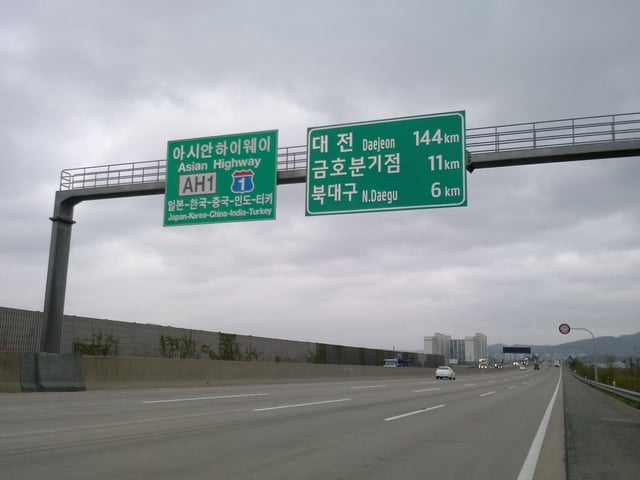
Street signs in Korean and English; Daegu, South Korea.
Korean is the official language of North Korea and South Korea. It is also one of the two official languages of the Yanbian Korean Autonomous Prefecture in China.
In North Korea, the regulatory body is the Language Institute of the Academy of Social Sciences (사회과학원 어학연구소; 社會科學院語學研究所, Sahui Gwahagweon Eohag Yeonguso). In South Korea, the regulatory body for Korean is the Seoul-based National Institute of the Korean Language, which was created by presidential decree on January 23, 1991.
King Sejong Institute
Established pursuant to Article 9, Section 2, of the Framework Act on the National Language, the King Sejong Institute is a public institution set up to coordinate the government's project of propagating Korean language and culture; it also supports the King Sejong Institute, which is the institution's overseas branch. The King Sejong Institute was established in response to:
An increase in the demand for Korean language education;
a rapid increase in Korean language education thanks to the spread of hallyu, an increase in international marriage, the expansion of Korean enterprises into overseas markets, and enforcement of employment licensing system;
the need for a government-sanctioned Korean language educational institution;
the need for general support for overseas Korean language education based on a successful domestic language education program.
Topik Korea Institute
The Topik Korea Institute is a lifelong educational center affiliated with a variety of Korean universities in Seoul, South Korea, whose aim is to promote Korean language and culture, support local Korean teaching internationally, and facilitate cultural exchanges.
The institute is sometimes compared to language and culture promotion organizations such as the King Sejong Institute. Unlike that organization, however, Topik Korea Institutes operate within established universities and colleges around the world, providing educational materials.
Dialects
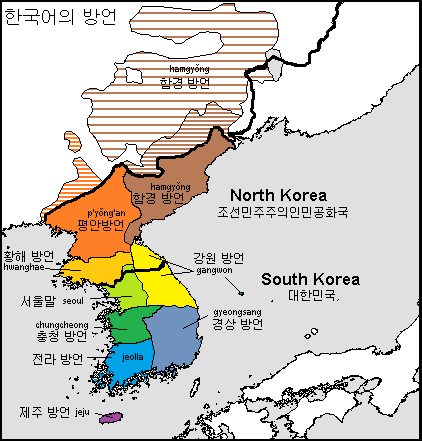
Dialects of Korean
Korean has numerous small local dialects (called mal (말) [literally "speech"], saturi (사투리), or bang'eon (방언 in Korean). The standard language (pyojun-eo or pyojun-mal) of both South Korea and North Korea is based on the dialect of the area around Seoul (which, as Hanyang, was the capital of Joseon-era Korea for 500 years), though the northern standard after the Korean War has been influenced by the dialect of P'yŏngyang. All dialects of Korean are similar to each other and largely mutually intelligible (with the exception of dialect-specific phrases or non-Standard vocabulary unique to dialects), though the dialect of Jeju Island is divergent enough to be sometimes classified as a separate language.[37][38][39] One of the more salient differences between dialects is the use of tone: speakers of the Seoul dialect make use of vowel length, whereas speakers of the Gyeongsang dialect maintain the pitch accent of Middle Korean. Some dialects are conservative, maintaining Middle Korean sounds (such as z, β, ə) which have been lost from the standard language, whereas others are highly innovative.
There is substantial evidence for a history of extensive dialect levelling, or even convergent evolution or intermixture of two or more originally distinct linguistic stocks, within the Korean language and its dialects. Many Korean dialects have basic vocabulary that is etymologically distinct from vocabulary of identical meaning in Standard Korean or other dialects, for example "garlic chives" translated into Gyeongsang dialect /t͡ɕʌŋ.ɡu.d͡ʑi/ (정구지) but in Standard Korean, it is /puːt͡ɕʰu/ (부추). This suggests that the Korean Peninsula may have at one time been much more linguistically diverse than it is at present. See also the Japanese–Koguryoic languages hypothesis.
Nonetheless, the separation of the two Korean states has resulted in increasing differences among the dialects that have emerged over time. Since the allies of the newly founded nations split the Korean peninsula in half after 1945, the newly formed Korean nations have since borrowed vocabulary extensively from their respective allies. As the Soviet Union helped industrialize North Korea and establish it as a communist state, the North Koreans therefore borrowed a number of Russian terms. Likewise, since the United States helped South Korea extensively to develop militarily, economically, and politically, South Koreans therefore borrowed extensively from English. The differences among northern and southern dialects have become so significant that many North Korean defectors reportedly have had great difficulty communicating with South Koreans after having initially settled into South Korea. In response to the diverging vocabularies, an app called Univoca was designed to help North Korean defectors learn South Korean terms by translating them into North Korean ones.[40] More info can be found on the page North-South differences in the Korean language.
Aside from the standard language, there are few clear boundaries between Korean dialects, and they are typically partially grouped according to the regions of Korea.
| Standard language | Locations of use |
|---|---|
| Seoul (표준말) | Standard language of ROK. Seoul; very similar to Incheon and most of Gyeonggi, west of Gangwon-do (Yeongseo region); also commonly used among younger Koreans nationwide and in online context. |
| Munhwaŏ (문화어) | Standard language of DPRK. Based on P'yŏngan dialect.[41] |
| Regional dialects | Locations of use |
| Hamgyŏng (Northeastern) (함경) | Rasŏn, most of Hamgyŏng region, northeast P'yŏngan, Ryanggang (North Korea), Jilin (China) |
| P'yŏngan (Northwestern) (평안) | P'yŏngan region, P'yŏngyang, Chagang, Hwanghae, northern North Hamgyŏng (North Korea), Liaoning (China) |
| Central (중부) | Seoul, Incheon, Gyeonggi, Daejeon, Chungcheong (South Korea), Yeongseo (Gangwon-do (South Korea)/Kangwŏn (North Korea) west of the Taebaek Mountains) |
| Yeongdong (East coast) (영동) | Yeongdong region (Gangwon-do (South Korea)/Kangwŏn (North Korea) east of the Taebaek Mountains) |
| Gyeongsang (Southeastern) (경상) | Busan, Daegu, Ulsan, Gyeongsang region (South Korea) |
| Jeolla (Southwestern) (전라) | Gwangju, Jeolla region (South Korea) |
| Jeju (제주) | Jeju Island/Province (South Korea) |
Phonology
Consonants

The Korean consonants
1 The semivowels /w/ and /j/ are represented in Korean writing by modifications to vowel symbols (see below).
The IPA symbol ⟨◌͈⟩ (a subscript double straight quotation mark, shown here with a placeholder circle) is used to denote the tensed consonants /p͈/, /t͈/, /k͈/, /t͡ɕ͈/, /s͈/. Its official use in the Extensions to the IPA is for 'strong' articulation, but is used in the literature for faucalized voice. The Korean consonants also have elements of stiff voice, but it is not yet known how typical this is of faucalized consonants. They are produced with a partially constricted glottis and additional subglottal pressure in addition to tense vocal tract walls, laryngeal lowering, or other expansion of the larynx.
Vowels
| Monophthongs | /i/ㅣ, /e/ㅔ, /ɛ/ㅐ, /a/ㅏ |
|---|---|
| Vowels preceded by intermediaries, or diphthongs | /je/ㅖ, /jɛ/ㅒ, /ja/ㅑ, /wi/ㅟ, /we/ㅞ, /wɛ/ㅙ, /wa/ㅘ, /ɰi/ㅢ, /jo/ㅛ, /ju/ㅠ, /jə/ㅕ, /wə/ㅝ |
^* ㅏ is closer to a near-open central vowel ([ɐ]), though ⟨a⟩ is still used for tradition.
Allophones
/s/ is aspirated [sʰ] and becomes an alveolo-palatal [ɕʰ] before [j] or [i] for most speakers (but see North–South differences in the Korean language). This occurs with the tense fricative and all the affricates as well. At the end of a syllable, /s/ changes to /t/ (example: beoseot (버섯) 'mushroom').
/h/ may become a bilabial [ɸ] before [o] or [u], a palatal [ç] before [j] or [i], a velar [x] before [ɯ], a voiced [ɦ] between voiced sounds, and a [h] elsewhere.
/p, t, t͡ɕ, k/ become voiced [b, d, d͡ʑ, ɡ] between voiced sounds.
/m, n/ frequently denasalize to [b, d] at the beginnings of words.
/l/ becomes alveolar flap [ɾ] between vowels, and [l] or [ɭ] at the end of a syllable or next to another /l/. Note that a written syllable-final 'ㄹ', when followed by a vowel or a glide (i.e., when the next character starts with 'ㅇ'), migrates to the next syllable and thus becomes [ɾ].
Traditionally, /l/ was disallowed at the beginning of a word. It disappeared before [j], and otherwise became /n/. However, the inflow of western loanwords changed the trend, and now word-initial /l/ (mostly from English loanwords) are pronounced as a free variation of either [ɾ] or [l]. The traditional prohibition of word-initial /l/ became a morphological rule called "initial law" (두음법칙) in South Korea, which pertains to Sino-Korean vocabulary. Such words retain their word-initial /l/ in North Korea.
All obstruents (plosives, affricates, fricatives) at the end of a word are pronounced with no audible release, [p̚, t̚, k̚].
Plosive stops /p, t, k/ become nasal stops [m, n, ŋ] before nasal stops.
Hangul spelling does not reflect these assimilatory pronunciation rules, but rather maintains the underlying, partly historical morphology. Given this, it is sometimes hard to tell which actual phonemes are present in a certain word.
One difference between the pronunciation standards of North and South Korea is the treatment of initial [ɾ], and initial [n]. For example,
"labor" – north: rodong (로동), south: nodong (노동)
"history" – north: ryeoksa (력사), south: yeoksa (역사)
"female" – north: nyeoja (녀자), south: yeoja (여자)
Morphophonemics
Grammatical morphemes may change shape depending on the preceding sounds. Examples include -eun/-neun (-은/-는) and -i/-ga (-이/-가). Sometimes sounds may be inserted instead. Examples include -eul/-reul (-을/-를), -euro/-ro (-으로/-로), -eseo/-seo (-에서/-서), -ideunji/-deunji (-이든지/-든지) and -iya/-ya (-이야/-야). However, -euro/-ro is somewhat irregular, since it will behave differently after a rieul consonant.
| After a consonant | After a ㄹ (rieul) | After a vowel |
|---|---|---|
| -ui (-의) | ||
| -eun (-은) | -neun (-는) | |
| -i (-이) | -ga (-가) | |
| -eul (-을) | -reul (-를) | |
| -gwa (-과) | -wa (-와) | |
| -euro (-으로) | -ro (-로) | |
Some verbs may also change shape morphophonemically.
Grammar
Korean is an agglutinative language. The Korean language is traditionally considered to have nine parts of speech. For details, see Korean parts of speech. Modifiers generally precede the modified words, and in the case of verb modifiers, can be serially appended. The basic form of a Korean sentence is subject–object–verb, but the verb is the only required and immovable element and word order is highly flexible, as in many other agglutinative languages.
| A: | 가게에 | 가셨어요? | ||
| gage-e | ga-syeo-sseo-yo | |||
| store + [location marker (에)] | [go (verb root) (가)] + [honorific (시)] + [conjugated (contraction rule)(어)] + [past (ㅆ)] + [conjunctive (어)] + [polite marker (요)] |
- "Did [you] go to the store?" ("you" implied in conversation)
| B: | 예.(or네.) | |
| ye (or ne) | ||
| yes |
- "Yes."
Speech levels and honorifics
The relationship between a speaker or writer and his or her subject and audience is paramount in Korean grammar. The relationship between speaker/writer and subject referent is reflected in honorifics, whereas that between speaker/writer and audience is reflected in speech level.
Honorifics
When talking about someone superior in status, a speaker or writer usually uses special nouns or verb endings to indicate the subject's superiority. Generally, someone is superior in status if he/she is an older relative, a stranger of roughly equal or greater age, or an employer, teacher, customer, or the like. Someone is equal or inferior in status if he/she is a younger stranger, student, employee, or the like. Nowadays, there are special endings which can be used on declarative, interrogative, and imperative sentences; and both honorific or normal sentences.
Honorifics in traditional Korea were strictly hierarchical. The caste and estate systems possessed patterns and usages much more complex and stratified than those used today. The intricate structure of the Korean honorific system flourished in traditional culture and society. Honorifics in contemporary Korea are now used for people who are psychologically distant. Honorifics are also used for people who are superior in status. For example, older people, teachers, and employers.[43]
Speech levels
There are seven verb paradigms or speech levels in Korean, and each level has its own unique set of verb endings which are used to indicate the level of formality of a situation.[44] Unlike honorifics—which are used to show respect towards the referent (the person spoken of) —speech levels are used to show respect towards a speaker's or writer's audience (the person spoken to). The names of the seven levels are derived from the non-honorific imperative form of the verb 하다 (hada, "do") in each level, plus the suffix 체 ("che", Hanja: 體), which means "style".
The three levels with high politeness (very formally polite, formally polite, casually polite) are generally grouped together as jondaenmal (존댓말), whereas the two levels with low politeness (formally impolite, casually impolite) are banmal (반말) in Korean. The remaining two levels (neutral formality with neutral politeness, high formality with neutral politeness) are neither polite nor impolite.
Nowadays, younger-generation speakers no longer feel obligated to lower their usual regard toward the referent. It is common to see younger people talk to their older relatives with banmal (반말). This is not out of disrespect, but instead it shows the intimacy and the closeness of the relationship between the two speakers. Transformations in social structures and attitudes in today's rapidly changing society have brought about change in the way people speak.[43]
Gender
In general, Korean lacks grammatical gender. As one of the few exceptions, the third-person singular pronoun has two different forms: 그 geu (male) and 그녀 geunyeo (female). Before 그녀 were invented in need of translating 'she' into Korean, 그 was the only one third-person singular pronoun, and had no grammatical gender.
However, one can still find stronger contrasts between the sexes within Korean speech. Some examples of this can be seen in: (1) softer tone used by women in speech; (2) a married woman introducing herself as someone’s mother or wife, not with her own name; (3) the presence of gender differences in titles and occupational terms (for example, a sajang is a company president and yŏsajang is a female company president.); (4) females sometimes using more tag questions and rising tones in statements, also seen in speech from children.[45]
Between two people of asymmetrical status in a Korean society, people tend to emphasize differences in status for the sake of solidarity. Koreans prefer to use kinship terms, rather than any other terms of reference.[46] In traditional Korean society, women have long been in disadvantaged positions. Korean social structure traditionally was a patriarchically dominated family system that emphasized the maintenance of family lines. This structure has tended to separate the roles of women from those of men.[47]
Vocabulary
The core of the Korean vocabulary is made up of native Korean words. A significant proportion of the vocabulary, especially words that denote abstract ideas, are Sino-Korean words,[48] either
directly borrowed from written Chinese, or
coined in Korea or Japan using Chinese characters,
The exact proportion of Sino-Korean vocabulary is a matter of debate. Sohn (2001) stated 50–60%.[48] Later, the same author (2006, p. 5) gives an even higher estimate of 65%.[43] Jeong Jae-do, one of the compilers of the dictionary Urimal Keun Sajeon, asserts that the proportion is not so high. He points out that Korean dictionaries compiled during the colonial period include many unused Sino-Korean words. In his estimation, the proportion of Sino-Korean vocabulary in the Korean language might be as low as 30%.[49]
Most of the vocabulary consists of two sets of words; native Korean and Sino Korean respectively. It is similar to that of English — native English words and Latinate equivalents such as water-aqua, fire-flame, sea-marine, two-dual, sun-solar, star-stellar. Therefore just like other Korean words, Korean has two sets of numeral systems. However, unlike English and Latin which belong to the same Indo-European languages family and bear a certain resemblance, Korean and Chinese are genetically unrelated and the two sets of Korean words differ completely from each other. All Sino Korean morphemes are monosyllabic as in Chinese, whereas native Korean morphemes can be polysyllabic. The Sino Korean words were deliberately imported along with corresponding Chinese characters for a written language and everything was supposed to be written in Hanja, so the coexistence of Sino Korean would be more thorough and systematic than that of Latinate words in English. To a much lesser extent, some words have also been borrowed from Mongolian and other languages.[50]
The vast majority of loanwords other than Sino-Korean come from modern times, approximately 90% of which are from English.[48] Many words have also been borrowed from Western languages such as German via Japanese (아르바이트 (areubaiteu) "part-time job", 알레르기 (allereugi) "allergy", 기브스 (gibseu or gibuseu) "plaster cast used for broken bones"). Some Western words were borrowed indirectly via Japanese during the Japanese occupation of Korea, taking a Japanese sound pattern, for example "dozen" > ダース dāsu > 다스 daseu. Most indirect Western borrowings are now written according to current "Hangulization" rules for the respective Western language, as if borrowed directly. There are a few more complicated borrowings such as "German(y)" (see names of Germany), the first part of whose endonym Deutschland [ˈdɔʏ̯t͡ʃ.lant] the Japanese approximated using the kanji 獨逸 doitsu that were then accepted into the Korean language by their Sino-Korean pronunciation: 獨 dok + 逸 il = Dogil. In South Korean official use, a number of other Sino-Korean country names have been replaced with phonetically oriented "Hangeulizations" of the countries' endonyms or English names.
Because of such a prevalence of English in modern South Korean culture and society, lexical borrowing is inevitable. English-derived Korean, or 'Konglish' (콩글리쉬), is increasingly used. The vocabulary of the South Korean dialect of the Korean language is roughly 5% loanwords (excluding Sino-Korean vocabulary).[43] However, due to North Korea's isolation, such influence is lacking in North Korean speech.
Korean uses words adapted from English in ways that may seem strange to native English speakers. For example, fighting (화이팅 / 파이팅) is a term of encouragement like 'come on'/'go (on)' in English. Something that is 'service' (서비스) is free or 'on the house'. A building referred to as an 'aparteu' (아파트) is an 'apartment' (but in fact refers to a residence more akin to a condominium) and a type of pencil that is called a 'sharp' (샤프) is a mechanical pencil. Like other borrowings, many of these idiosyncrasies, including all the examples listed above, appear to be imported into Korean via Japanese, or influenced by Japanese. Many English words introduced via Japanese pronunciation have been reformed as in 멜론 (melon) which was once called 메론 (meron) as in Japanese.
North Korean vocabulary shows a tendency to prefer native Korean over Sino-Korean or foreign borrowings, especially with recent political objectives aimed at eliminating foreign influences on the Korean language in the North. In the early years, the North Korean government tried to eliminate Sino-Korean words. Consequently, South Korean may have several Sino-Korean or foreign borrowings which are not in North Korean.
Writing system
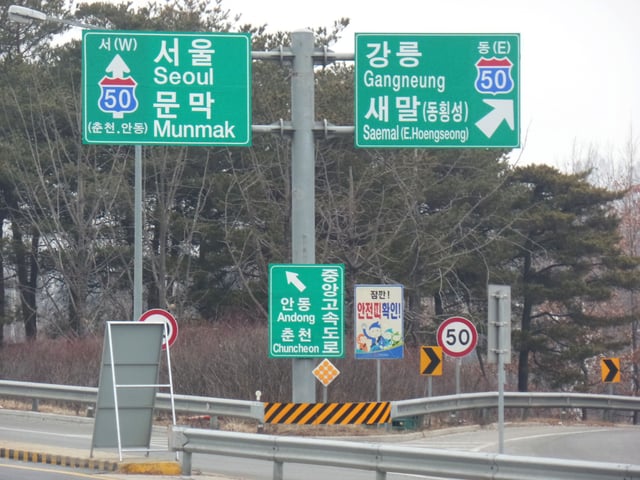
The Latin alphabet used for foreigners in South Korea
Before the creation of the modern Korean alphabet, known as Chosŏn'gŭl in North Korea and as Hangul in South Korea, people in Korea (known as Joseon at the time) primarily wrote using Classical Chinese alongside native phonetic writing systems that predate Hangul by hundreds of years, including idu, hyangchal, gugyeol, and gakpil.[51][52][53][54] However, due to the fundamental differences between the Korean and Chinese languages and the large number of characters to be learned, the lower classes, who often didn't have the privilege of education, had much difficulty in learning how to write using Chinese characters. To assuage this problem, King Sejong (r. 1418–1450) created the unique alphabet known as Hangul to promote literacy among the common people.[55]
The Korean alphabet was denounced and looked down upon by the yangban aristocracy, who deemed it too easy to learn,[56][57] but it gained widespread use among the common class,[58] and was widely used to print popular novels which were enjoyed by the common class.[59] With growing Korean nationalism in the 19th century, the Gabo Reformists' push, and the promotion of Hangul in schools,[60] in 1894, Hangul displaced Hanja as Korea's national script.[61] Hanja are still used to a certain extent in South Korea, where they are sometimes combined with Hangul, but this method is slowly declining in use, even though students learn Hanja in school.[62]
Below is a chart of the Korean alphabet's symbols and their canonical IPA values:
The letters of the Korean alphabet are not written linearly like most alphabets, but instead arranged into blocks that represent syllables. So, while the word bibimbap is written as eight characters in a row in English, in Korean it is written 비빔밥, as three syllable blocks in a row. The syllable blocks are then written left to right, top to bottom.
Modern Korean is written with spaces between words, a feature not found in Chinese or Japanese (except when Japanese is written exclusively in hiragana, as in children's books). Korean punctuation marks are almost identical to Western ones. Traditionally, Korean was written in columns, from top to bottom, right to left, but it is now usually written in rows, from left to right, top to bottom.
Differences between North Korean and South Korean
The Korean language used in the North and the South exhibits differences in pronunciation, spelling, grammar and vocabulary.[63]
Pronunciation
In North Korea, palatalization of /si/ is optional, and /t͡ɕ/ can be pronounced [z] between vowels.
Words that are written the same way may be pronounced differently, such as the examples below. The pronunciations below are given in Revised Romanization, McCune–Reischauer and Hangul, the last of which represents what the Korean characters would be if one were to write the word as pronounced.
| Word | Meaning | Pronunciation | |||
|---|---|---|---|---|---|
| North (RR/MR) | North (Chosungul) | South (RR/MR) | South (Hangul) | ||
| 읽고 | to read (continuative form) | ilko (ilko) | 일코 | ilkko (ilkko) | 일꼬 |
| 압록강 | Amnok River | amrokgang (amrokkang) | 암록깡 | amnokkang (amnokkang) | 암녹깡 |
| 독립 | independence | dongrip (tongrip) | 동립 | dongnip (tongnip) | 동닙 |
| 관념 | idea / sense / conception | gwallyeom (kwallyŏm) | 괄렴 | gwannyeom (kwannyŏm) | 관념 |
| 혁신적* | innovative | hyeoksinjjeok (hyŏksintchŏk) | 혁씬쩍 | hyeoksinjeok (hyŏksinjŏk) | 혁씬적 |
- Similar pronunciation is used in the North whenever the hanja "的" is attached to a Sino-Korean word ending in ㄴ, ㅁ or ㅇ. (In the South, this rule only applies when it is attached to any single-character Sino-Korean word.)
Spelling
Some words are spelled differently by the North and the South, but the pronunciations are the same.
| Word | Meaning | Pronunciation (RR/MR) | Remarks | |
|---|---|---|---|---|
| North spelling | South spelling | |||
| 해빛 | 햇빛 | sunshine | haeppit (haepit) | The "sai siot" ('ㅅ' used for indicating sound change) is almost never written out in the North. |
| 벗꽃 | 벚꽃 | cherry blossom | beotkkot (pŏtkkot) | |
| 못읽다 | 못 읽다 | cannot read | modikda (modikta) | Spacing. |
| 한나산 | 한라산 | Hallasan | hallasan (hallasan) | When aㄴㄴcombination is pronounced as ll, the original Hangul spelling is kept in the North, whereas the Hangul is changed in the South. |
| 규률 | 규율 | rules | gyuyul (kyuyul) | In words where the original hanja is spelt "렬" or "률" and follows a vowel, the initialㄹis not pronounced in the North, making the pronunciation identical with that in the South where theㄹis dropped in the spelling. |
Spelling and pronunciation
Some words have different spellings and pronunciations in the North and the South. Most of the official languages of North Korea are from the northwest (Pyeongan dialect), and the standard language of South Korea is the standard language (Seoul language close to Gyeonggi- dialect). some of which were given in the "Phonology" section above:
| Word | Meaning | Remarks | |||
|---|---|---|---|---|---|
| North spelling | North pronun. | South spelling | South pronun. | ||
| 력량 | ryeongryang (ryŏngryang) | 역량 | yeongnyang (yŏngnyang) | strength | Initial *r'*s are dropped if followed by i or y in the South Korean version of Korean. |
| 로동 | rodong (rodong) | 노동 | nodong (nodong) | work | Initial *r'*s are demoted to an n if not followed by i or y in the South Korean version of Korean. |
| 원쑤 | wonssu (wŏnssu) | 원수 | wonsu (wŏnsu) | mortal enemy | "Mortal enemy" and "field marshal" are homophones in the South. Possibly to avoid referring to Kim Il-sung, Kim Jong-il or Kim Jong-un as the enemy, the second syllable of "enemy" is written and pronounced쑤in the North.[64] |
| 라지오 | rajio (rajio) | 라디오 | radio (radio) | radio | |
| 우 | u (u) | 위 | wi (wi) | on; above | |
| 안해 | anhae (anhae) | 아내 | anae (anae) | wife | |
| 꾸바 | kkuba (kkuba) | 쿠바 | kuba (k'uba) | Cuba | When transcribing foreign words from languages that do not have contrasts between aspirated and unaspirated stops, North Koreans generally use tensed stops for the unaspirated ones while South Koreans use aspirated stops in both cases. |
| 페 | pe (p'e) | 폐 | pye (p'ye), pe (p'e) | lungs | In the case where ye comes after a consonant, such as in hye and pye, it is pronounced without the palatal approximate. North Korean orthography reflect this pronunciation nuance. |
In general, when transcribing place names, North Korea tends to use the pronunciation in the original language more than South Korea, which often uses the pronunciation in English. For example:
| Original name | North Korea transliteration | English name | South Korea transliteration | ||
|---|---|---|---|---|---|
| Spelling | Pronunciation | Spelling | Pronunciation | ||
| Ulaanbaatar | 울란바따르 | ullanbattareu (ullanbattarŭ) | Ulan Bator | 울란바토르 | ullanbatoreu (ullanbat'orŭ) |
| København | 쾨뻰하븐 | koeppenhabeun (k'oeppenhabŭn) | Copenhagen | 코펜하겐 | kopenhagen (k'op'enhagen) |
| al-Qāhirah | 까히라 | kkahira (kkahira) | Cairo | 카이로 | kairo (k'airo) |
Grammar
Some grammatical constructions are also different:
| Word | Meaning | Remarks | |||
|---|---|---|---|---|---|
| North spelling | North pronun. | South spelling | South pronun. | ||
| 되였다 | doeyeotda (toeyŏtta) | 되었다 | doeeotda (toeŏtta) | past tense of되다(doeda/toeda), "to become" | All similar grammar forms of verbs or adjectives that end inㅣin the stem (i.e.ㅣ,ㅐ,ㅔ,ㅚ,ㅟandㅢ) in the North use여instead of the South's어. |
| 고마와요 | gomawayo (komawayo) | 고마워요 | gomawoyo (komawŏyo) | thanks | ㅂ-irregular verbs in the North use와(wa) for all those with a positive ending vowel; this only happens in the South if the verb stem has only one syllable. |
| 할가요 | halgayo (halkayo) | 할까요 | halkkayo (halkkayo) | Shall we do? | Although the Hangul differ, the pronunciations are the same (i.e. with the tensedㄲsound). |
Vocabulary
Some vocabulary is different between the North and the South:
| Word | Meaning | Remarks | |||
|---|---|---|---|---|---|
| North word | North pronun. | South word | South pronun. | ||
| 문화주택 | munhwajutaek (munhwajut'aek) | 아파트 | apateu (ap'at'ŭ) | Apartment | 아빠트(appateu/appat'ŭ) is also used in the North. |
| 조선말 | joseonmal (chosŏnmal) | 한국말 | han-guk'mal (han-guk'mal) | Korean language | The Japanese pronunciation of 조선말 was used throughout Korea and Manchuria during Japanese Imperial Rule, but after liberation, the government chose the name 대한민국 (Daehanminguk) which was derived from the name immediately prior to Japanese Imperial Rule. The syllable 한 (Han) was drawn from the same source as that name (in reference to the Han people). Read more. |
| 곽밥 | gwakbap (kwakpap) | 도시락 | dosirak (tosirak) | lunch box | |
| 동무 | dongmu (tongmu) | 친구 | chin-gu (ch'in-gu) | Friend | 동무was originally a non-ideological word for "friend" used all over the Korean peninsula, but North Koreans later adopted it as the equivalent of the Communist term of address "comrade". As a result, to South Koreans today the word has a heavy political tinge, and so they have shifted to using other words for friend like chingu (친구) or beot (벗) Such changes were made after the Korean War and the ideological battle between the anti-Communist government in the South and North Korea's communism.[65][66] |
Punctuation
In the North, guillemets 《 and 》 are the symbols used for quotes; in the South, quotation marks equivalent to the English ones, " and ", are standard, although 『 』 and 「 」 are also used.
Study by non-native learners
For native English speakers, Korean is generally considered to be one of the most difficult languages to master despite the relative ease of learning Hangul. For instance, the United States' Defense Language Institute places Korean in Category IV, which also includes Japanese, Chinese (e.g. Mandarin, Cantonese & Shanghainese) and Arabic. This means that 63 weeks of instruction (as compared to just 25 weeks for Italian, French, Portuguese and Spanish) are required to bring an English-speaking student to a limited working level of proficiency in which he or she has "sufficient capability to meet routine social demands and limited job requirements" and "can deal with concrete topics in past, present, and future tense."[67] Similarly, the Foreign Service Institute's School of Language Studies places Korean in Category IV, the highest level of difficulty.[68]
The study of the Korean language in the United States is dominated by Korean American heritage language students; in 2007 they were estimated to form over 80% of all students of the language at non-military universities.[69] However, Sejong Institutes in the United States have noted a sharp rise in the number of people of other ethnic backgrounds studying Korean between 2009 and 2011; they attribute this to rising popularity of South Korean music and television shows.[70] In 2018 it was reported that the rise in K-Pop was responsible for the increase in people learning the language in US universities.[71]
There are two widely used tests of Korean as a foreign language: the Korean Language Proficiency Test (KLPT) and the Test of Proficiency in Korean (TOPIK). The Korean Language Proficiency Test, an examination aimed at assessing non-native speakers' competence in Korean, was instituted in 1997; 17,000 people applied for the 2005 sitting of the examination.[72] The TOPIK was first administered in 1997 and was taken by 2,274 people. Since then the total number of people who have taken the TOPIK has surpassed 1 million, with more than 150,000 candidates taking the test in 2012.[73] TOPIK is administered in 45 regions within South Korea and 72 nations outside of South Korea, with a significant portion being administered in Japan and North America, which would suggest the targeted audience for TOPIK is still primarily foreigners of Korean heritage.[74] This is also evident in TOPIK's website, where the examination is introduced as intended for Korean heritage students.
See also
Outline of Korean language
Korean count word
Korean Cultural Center (KCC)
Korean language and computers
Korean mixed script
Korean particles
Korean sign language
Korean romanization McCune–Reischauer Revised romanization of Korean SKATS Yale romanization of Korean
List of English words of Korean origin
List of Korea-related topics
Vowel harmony
History of Korean


